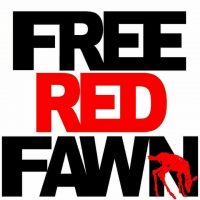Late one night this past April, four people on off-road vehicles drove into a small, Indigenous village near the town of Blue River in British Columbia, Canada. It was dark and the vehicles drove through deep snow, smashing through wooden signs and barriers that guarded the village of tiny houses, erected in the path of a long-distance oil pipeline that runs from Alberta to the Pacific Coast.
The attackers punched and kicked a man, shouting profanity and racial slurs. One of them stole a truck and used it to mow down a display of red dresses, hung as a memorial to missing and murdered Indigenous women and girls, who are disproportionally affected by violence. The driver then crashed the truck into one of the houses.
The small houses were built by Secwepemc and Ktunaxa people, who built them to assert their rights over unceded Indigenous land, through which an expansion of the Trans Mountain pipeline is slated to carry diluted tar sands oil. Members of the village believe the attack was related to their opposition to the pipeline.
Confrontation between the Trans Mountain pipeline expansion and a variety of Indigenous and environmental groups is heating up, precisely because the new pipeline is now moving forward with construction after years of legal battles.
The government of Prime Minister Justin Trudeau purchased the Trans Mountain system from Kinder Morgan in 2018 in order to keep the expansion alive. Texas-based Kinder Morgan was about to scrap the project, but Canada bought it for C$4.5 billion and vowed to see a second, “twin,” pipeline built alongside the existing line. The expansion would triple the system’s capacity to 890,000 barrels of oil per day, allowing Alberta’s tar sands to expand to overseas markets.
In July, Canada’s Supreme Court dismissed an appeal from a group of Indigenous nations, who say the consultation process was flawed because the government, which now owns the pipeline project, is also the one that approved it just a year later. “To let the federal government be its own judge and jury of its consultation process was flawed in so many ways,” Syeta’xtn (Chris Lewis) of the Squamish Nation told the CBC.
The court decision removed a major obstacle and the project is moving forward with construction. Yet, opponents are not giving up. “This project is probably the most controversial pipeline in Canadian history, so that’s saying something,” said Sven Biggs, Canadian Oil and Gas Programs Director at environmental group Stand.earth.
THE TINY HOUSE WARRIORS AND THE BATTLE FOR INDIGENOUS RIGHTS
In 2018, a group of Secwepemc and Ktunaxa people built six small houses on wheels and positioned them along the pipeline route to block construction near the community of Blue River in British Columbia. The immediate aim was to prevent the pipeline from moving forward, but the broader goal of the “Tiny House Warriors” was to assert authority over unceded traditional land, where Indigenous title has not been given up or acquired by the Crown in Canada.
“That’s what Tiny House Warriors is. It’s where we face off with the colonial government and their assumption of jurisdiction and authority over our Secwepemc territorial authority and jurisdiction,” said Kanahus Manuel, an Indigenous activist who is Secwepemc and Ktunaxa and a leader of Tiny House Warriors.
In an interview with DeSmog, Manuel described a pattern of harassment and intimidation from industry, oil and gas workers, police, and the state. The determination of Manuel and other Indigenous groups to assert their rights over unceded land has been met with stiff, and sometimes violent, opposition
